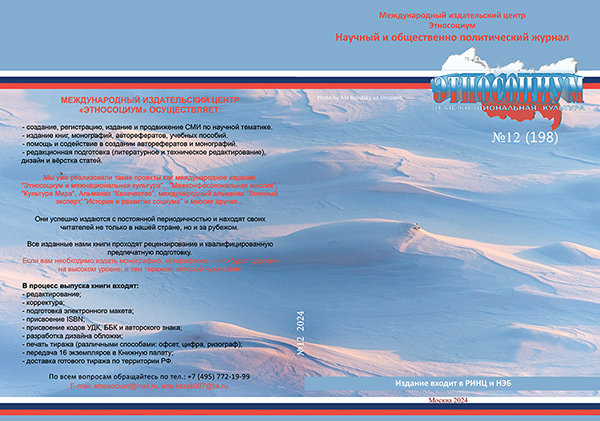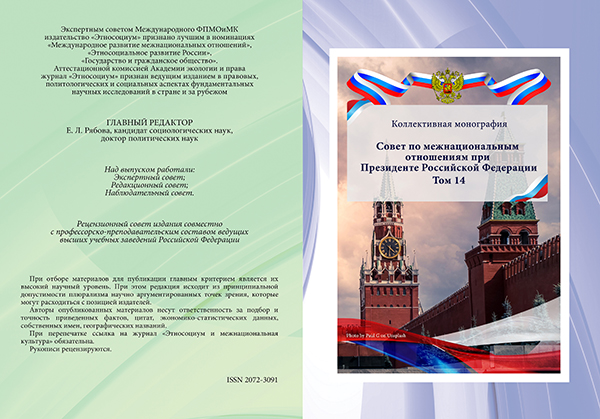

Content
|
COUNCIL ON INTERETHNIC RELATIONS UNDER THE PRESIDENT OF THE RUSSIAN FEDERATION
|
|
|
Ryabova E.L., Ternovaya L.O. Boundary river: its limological benefits, geopolitical watersheds and wastes
|
9
|
|
Sundukov D.D. Patriotism as a research problem in the political history of Russia
|
18
|
|
REGIONAL RESEARCH
|
|
|
Bodrovа E.E. State regional policy in the Russian federation
|
28
|
|
CURRENT PROBLEMS OF MODERN SOCIETY
|
|
|
Fanin R.V. Innovations in human resource provisioning of modern organizations
|
35
|
|
Arkhipov K.N., Mikhailov V.A. Federal projects for the renewal of public passenger transport in 2024: implementation and development prospects
|
42
|
|
Kuzin A.S. Trends in the development of information security in the military sphere
|
51
|
|
INTERNATIONAL RELATIONS
|
|
|
Narbut K.A. BRICS expansion following the 15th summit – new opportunities for unification and the Russian Federation
|
57
|
|
Iroshkina T.V. The role of the city in achieving sustainable development in a regional integration association (on the example of the EAEU)
|
74
|
|
Lyapunova M.M. Economic cooperation between Germany and Argentina
|
90
|
|
Abstracts
|
97
|
|
Authors
|
107
|
|
Requirements to materials submitted to the international publishing house "Etnosocium"
|
110
|
The article is devoted to the problem of border rivers, which, despite the emergence of the idea of natural borders only in the 17th century, has deep historical roots. The origins of the conflicts of the different tribes living along the banks of the common rivers had not only an economic but also a geopolitical basis. International law has consistently developed a procedure for establishing boundary lines conditioned by river features. However, this legal working out of the issue does not exclude the existence of multiple points of contention concerning the transboundary rivers and existing on all continents.
Key words: geopolitics, limology, state borders, transboundary rivers, international rivers, conflicts.
The article is devoted to the study of the concept of "patriotism". A brief history of the idea of patriotism is offered. The meanings of patriotism are considered in the context of the historical process and changing political actions. In his research, the author focused on the development of the phenomenon of patriotism from Ancient Russia to the present.
Considering the very concept of "patriotism", the author of the article begins with Antiquity and Ancient Rome, up to the Middle Ages, where the focus of study from the very concept of patriotism turns to the development of the phenomenon of patriotism in Russia up to the present.
Key words: patriotism, Rus, Russian Empire, traditional values, virtues, Church, Rurikovich.
This article discusses issues related to regional policy in the Russian Federation.
Key words: regional policy, spatial development strategy of the Russian Federation, goals of the state policy of regional development in the Russian Federation, regional economic development programs.
This article is dedicated to the analysis of innovative approaches in human resource management of modern organizations. It examines the main directions and trends in the implementation of innovations in HR management, including the creation of specialized HR departments, the use of new communication and recruiting technologies, and the application of HR analytics and artificial intelligence. Special attention is given to the specificity of personnel as a key asset of the organization and the necessity of considering this specificity when developing innovative HR strategies. The article also addresses issues related to the evaluation of the effectiveness of innovative HR practices and their impact on the long-term competitiveness of the organization.
Key words: innovations in human resource management, HR management, HR technologies, human capital, organizational development, HR analytics, digitalization of HR, change management, strategic human resource management, organizational competitiveness.
This article examines the challenges of public transportation fleet renewal in the Russian Federation within the framework of the Transport Strategy implementation. The author identifies potential contradictions and proposes solutions. The analysis focuses on three key projects aimed at modernizing passenger transport: "Modernization of passenger transport in urban agglomerations" within the national project "Safe and High-Quality Roads," "Acquisition of rolling stock for ground public transport for subsequent leasing at the expense of the National Wealth Fund," and "Financing of measures to acquire rolling stock for public passenger transport within the limit of a special treasury loan provided by the Federal Treasury at the expense of temporarily free funds of the single account of the federal budget to the budgets of the constituent entities of the Russian Federation." The article argues for the need to optimize financing mechanisms, enhance the attractiveness of the profession of a driver, improve the tax system, and establish a unified, transparent financing model that takes into account the specifics of the Russian transport system.
Key words: public transport, federal projects, transport strategy of the Russian Federation, renewal of the rolling stock of urban passenger transport.
In the framework of this article, it was considered how the development of information security affects the military sphere. In the course of the study, the history of information security development was summarized in the form of three historical periods. For each of the generalized historical periods, the general characteristics and main tasks of ensuring information security in the military sphere were presented. The paper describes in detail the trends in the development of information security in the military sphere at each of these three historical stages. The author comes to the conclusion that the development of the personality of military personnel and the increase in their vigilance and personal responsibility for ensuring information security in the military sphere can be traced in all historical periods.
Keywords: information security, information security development trends, military vigilance.
The article considers the accession of new BRICS members following the 15th BRICS Summit in Johannesburg as a new round of opportunities to strengthen the role of the Russian Federation on the world stage. The author analyzes the prospects for the development of BRICS and the Russian Federation after the accession of new members. The main vectors of further development of the BRICS in terms of de-dollarization, the creation of a single BRICS currency, deepening economic integration between the members of the association and efforts to create a monopolar world are considered.
Key words: BRICS, enlargement, dedollarization, Russian Federation, XV BRICS Summit, Johannesburg Declaration II, multipolar world.
The special significance of cities in sustainable development is revealed. Global cities such as Moscow, St. Petersburg, Minsk, Almaty play a significant role in the economic and social development of the EAEU, are important hubs of economic activity and innovation, serve as financial and logistics hubs, which makes them key elements in the economic system of the Union.
Purpose of the study. To identify the contribution of cities to achieving sustainable development goals and their role as one of the "power factors" of the regional integration association.
Research objectives. To analyze the specifics of SDG localization at the city level using the example of Eurasian integration; to determine the role of cities in the context of the formation of a multipolar world system and strengthening its position as one of the "power factors" in the formation of a regional integration association; to determine the potential and capabilities of cities to achieve the SDGs in the context of sustainable development of the EAEU.
Methodology. A systems approach was necessary to analyze the areas of realizing the potential of EAEU cities to achieve the SDGs in their interrelationships and complexity. Empirical analysis allowed us to evaluate the practical steps and efforts of EAEU cities to achieve the SDGs, including the implementation of innovative projects and the rational use of the resource base.
Results. The data on the indices of sustainable development of EAEU cities were analyzed, on the basis of which the strengths and weaknesses in the development of urban systems were identified, which makes it possible to assess the contribution of cities to integration processes and show how important it is to strengthen interaction at the city level to achieve sustainable growth in the RIO.
Conclusions. The study examined the indicators of cities in the EAEU countries that demonstrate a significant contribution to the development of integration and the achievement of socio-economic goals. It was found that cities not only play the role of economic centers, but also create conditions for the growth of human capital. Large cities of the EAEU member states often become centers of attraction for migrants, which makes a significant contribution to the development of the labor market and stimulates the creation of new jobs. This is confirmed by the fact that the largest cities of the EAEU have the highest concentration of innovative enterprises and educational institutions, which allows them to be important components in achieving the sustainable development goals of the RIO and influence modern globalization processes of transition to a multipolar world.
Key words: SDGs, EAEU, regional integration, city, center of power, sustainability, development.
Economic globalization refers to the growing interdependence of world economies as a result of increased cross-border trade. Globalization processes increase people's access to goods and services, create new opportunities for financial markets, and provide national industries with greater access to international markets, resulting in countries becoming economically dependent on each other. No other country is so closely connected to the world economy and is so dependent on the world market situation as Germany, for which cooperation with Argentina is important, which can become a reliable partner for Germany in supplying gas during the energy transition, and in the medium term it can also become a strategic supplier of clean energy, green hydrogen and its derivatives.
Key words: German-Argentine cooperation, trade partner, trade turnover, MERCOSUR.